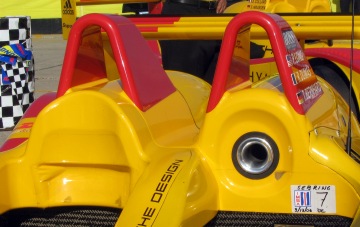 The
front suspension on the RS Spyder consists of upper and lower A-arms.
The lower A-arm mounted pushrod engages an inboard rocker arm to which
the torsion bars (1) are connected to. The torsion bars are mounted
rather low and on the side of the monocoque, resulting in a shallow pushrod
angle, for center of gravity considerations. The primary dampers
(2) are situated on the front of the tub with the anti-roll input (4, the
actual ARB is inside the monocoque) below and both being actuated from
the primary rocker arm input going into the torsion bar with a third damper
(3, also attached to the front face of the monocoque) receiving input as
well.
The
front suspension on the RS Spyder consists of upper and lower A-arms.
The lower A-arm mounted pushrod engages an inboard rocker arm to which
the torsion bars (1) are connected to. The torsion bars are mounted
rather low and on the side of the monocoque, resulting in a shallow pushrod
angle, for center of gravity considerations. The primary dampers
(2) are situated on the front of the tub with the anti-roll input (4, the
actual ARB is inside the monocoque) below and both being actuated from
the primary rocker arm input going into the torsion bar with a third damper
(3, also attached to the front face of the monocoque) receiving input as
well.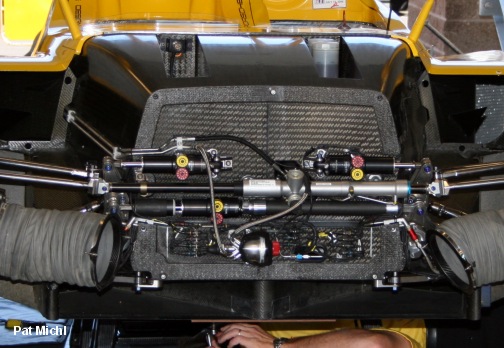 The
front (and rear suspension) layouts carry over from the 2006 car.
The
front (and rear suspension) layouts carry over from the 2006 car.The Spyder’s carbon monocoque consists of inner and outer carbon skins with varying thickness aluminum honeycomb in between. Unusually the tub is laminated in left and right halves, being glue bonded together on car centerline. A central carbon and honeycomb spine runs longitudinally through the cockpit, just offset of the centerline. Carbon internal bulkheads provide additional structure and driver protection. The RS’ footbox is raised to provide room for the front downforce generating splitter/diffuser. The monocoque is manufactured by Carbotech out of
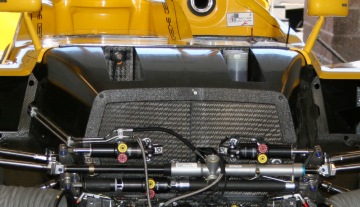 |
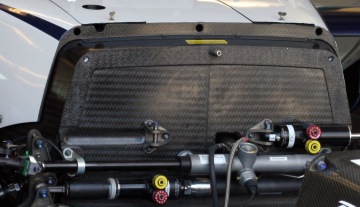 |
While we're looking at the front ends of the the 2006 RS Spyder (left) and 2007 RS Spyder (right), notice the carbon scuttle bonded to the top of the 2007 RS Spyder's monocoque. In 2006 the nose bodywork lifted off as a single piece revealing the top of the monocoque (and the access hatches) as well as the front crash structure (as well as suspension and all the mechanical bits). For '07 the nose bodywork split line has been redesigned and shifted forward, a scuttle is now bonded/riveted on to the top of the monocoque. The nose proper settles on top of the crash box and the fenders, with the trailing edge of the nose body work picking up on the leading edge of the scuttle.
|
|
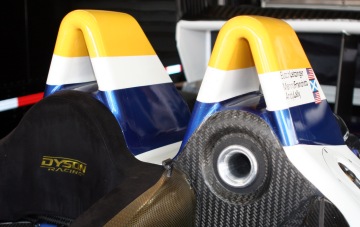 |
 The
rear suspension is similar with expected upper and lower A-arms, inboard
located torsion bars (1) mounted on a structural carbon housing atop the
bellhousing and actuated by a lower A-arm mounted pushrod. The primary
dampers (2) are mounted vertically either side the gearbox, just below
the torsion bars, and actuated by a rocker arm feeding off the same pushrod
input. A third damper (3) attaches in between the rockers.
The rear anti-roll bar (4) is mounted to the top of the carbon doghouse
and also takes input from the rocker.
The
rear suspension is similar with expected upper and lower A-arms, inboard
located torsion bars (1) mounted on a structural carbon housing atop the
bellhousing and actuated by a lower A-arm mounted pushrod. The primary
dampers (2) are mounted vertically either side the gearbox, just below
the torsion bars, and actuated by a rocker arm feeding off the same pushrod
input. A third damper (3) attaches in between the rockers.
The rear anti-roll bar (4) is mounted to the top of the carbon doghouse
and also takes input from the rocker.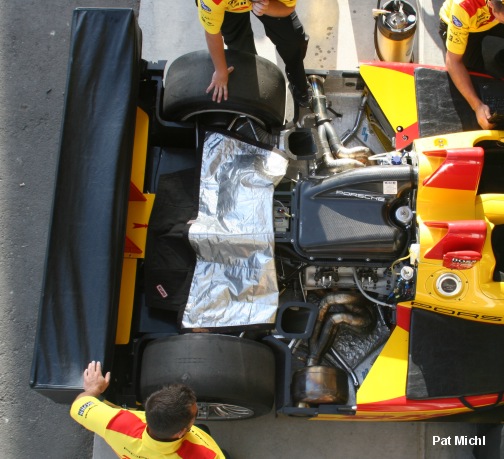 The
RS Spyder teams took to running only one muffler, favoring the side of
the car that the sound measuring device would be located on track (SLC 2007 here).
The
RS Spyder teams took to running only one muffler, favoring the side of
the car that the sound measuring device would be located on track (SLC 2007 here).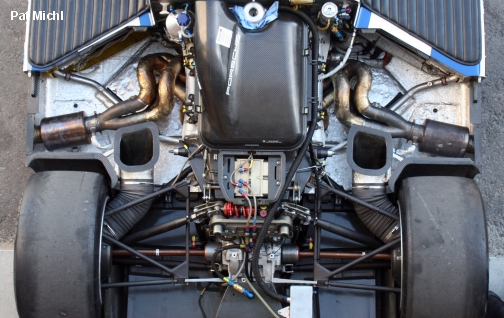 A
year on (SLC 2008) and we have mufflers on both left and right exits
and the massive "coffee can" (chamber pot anyone?) mufflers are gone
replaced by something more reasonable looking.
A
year on (SLC 2008) and we have mufflers on both left and right exits
and the massive "coffee can" (chamber pot anyone?) mufflers are gone
replaced by something more reasonable looking.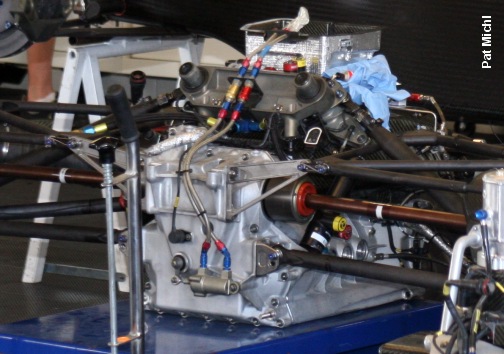 The
Spyder’s gearbox and bellhousing are cast as one in aluminum but with an
interesting structural carbon doghouse that sits atop the bellhousing and
serves as the mount for much of the rear suspension. The Porsche
designed GR6 gearbox is longitudinal and with the gear cluster as low as
possible, reducing the gearbox’s cross sectional impact on tunnel volume
and lowering the car’s center of gravity. Gear selection is made
electropneumatically via paddle shifters located on the steering wheel.
The
Spyder’s gearbox and bellhousing are cast as one in aluminum but with an
interesting structural carbon doghouse that sits atop the bellhousing and
serves as the mount for much of the rear suspension. The Porsche
designed GR6 gearbox is longitudinal and with the gear cluster as low as
possible, reducing the gearbox’s cross sectional impact on tunnel volume
and lowering the car’s center of gravity. Gear selection is made
electropneumatically via paddle shifters located on the steering wheel. 